Related Research Articles

East Devon is a constituency represented in the House of Commons of the UK Parliament since 2019 by Simon Jupp of the Conservative Party.
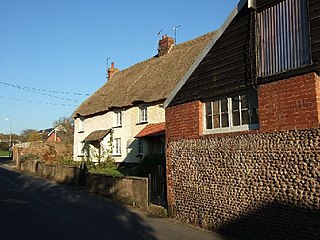
Woodbury is a village and civil parish in East Devon in the English county of Devon, 7 miles (11 km) south east of the city of Exeter. At the 2011 Census the village had a population of 1,605, and the parish had a population of 3,466. It lies on the east bank of the Exe Estuary, has borders – clockwise from the estuary – with the district of Exeter and then the parishes of Clyst St George, Clyst St Mary, Farringdon, Colaton Raleigh, Bicton and Lympstone. Woodbury is part of the electoral ward of Woodbury and Lympstone whose population at the 2011 Census was 5,260.

The South Devon is a British breed of large beef cattle. It originated in the counties of Devon and Cornwall in south-west England, and is mentioned from the eighteenth century. It was a dual-purpose breed, kept both for its milk and for beef. Since 1972 selection has been for beef only.

Clyst Rovers F.C. was a football club based in Clyst Honiton, near Exeter, Devon, England.

Broadclyst is a village and civil parish in the East Devon local government district. It lies approximately 5 miles northeast of the city of Exeter, Devon, England, on the B3181. In 2001 its population was 2,830, reducing at the 2011 Census to 1,467. An electoral ward with the same name exists whose population at the above census was 4,842.
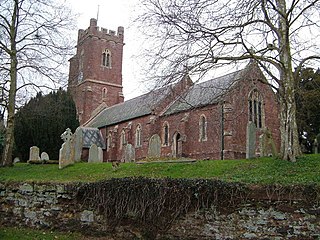
Sowton is a village and civil parish east of Exeter in East Devon, England. It has a population of 639.
Clyst St Mary is a small village and civil parish 3 miles (4.8 km) east of Exeter on the main roads to Exmouth and Sidmouth in East Devon. The name comes from the Celtic word clyst meaning 'clear stream'. The village is a major part of the electoral ward of Clyst Valley. At the 2011 Census this ward population was 2,326.
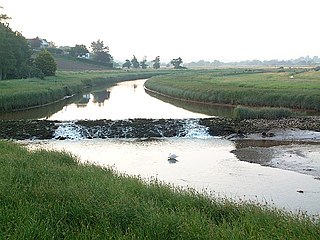
The River Clyst is a river of Devon, England. The name derives from Old English, and translates as Clean-stream. The river lends its name to several settlements on its route, Clyst Honiton, Clyst St Lawrence, Clyst St George, and Broadclyst. The William part of Clyst William derives from the Old English of aewelm, which means river source.
Events from the year 1455 in England.
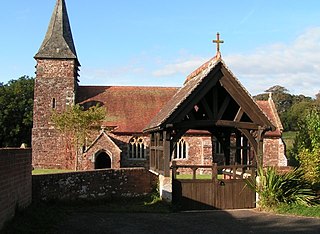
Farringdon is a village, civil parish and former manor in the district of East Devon in the county of Devon, England. The parish is surrounded clockwise from the north by the parishes of Clyst Honiton, Aylesbeare, a small part of Colaton Raleigh, Woodbury, Clyst St Mary and a small part of Sowton.
The Bonville–Courtenay feud of 1455 engendered a series of raids, sieges, and attacks between two major Devon families, the Courtenays and the Bonvilles, in south west England, in the mid-fifteenth century. One of many such aristocratic feuds of the time, it became entwined with national politics due to the political weight of the protagonists. The Courtenay earls of Devon were the traditional powerbrokers in the region, but by this time a local baronial family, the Bonvilles, had become more powerful and rivalled the Courtenays for royal patronage. Eventually this rivalry spilled over into physical violence, including social disorder, murder, and siege.

Today Clyst Heath is a suburb to the south east of the city of Exeter, Devon, England. An area of relatively high ground to the west of the River Clyst, it remained heathland until the early nineteenth century when it was cultivated for the first time.

Clyst Honiton is an English village and civil parish five miles from Exeter in the East Devon district, in the county of Devon. The church is St Michael and All Angels. Exeter International Airport which opened in 1938 is located on the outskirts of the village. The village was originally on the main A30 road from Exeter to Honiton but was bypassed in the 1990s. Another bypass to the east of the village linking the A30 to the new developments around Cranbrook opened in October 2013.

Clyst Hydon is a village and civil parish in the county of Devon, England. It was in the Cliston Hundred and has a church dedicated to St Andrew. The parish is surrounded, clockwise from the north, by the parishes of Cullompton, Plymtree, Payhembury, Talaton, Whimple, Clyst St Lawrence and Broad Clyst.

Clyst St Lawrence is a village and civil parish about 8 miles north-east of the city of Exeter in the county of Devon, England. Historically it formed part of Cliston Hundred. The parish is in the East Devon district and is surrounded, clockwise from the north, by the parishes of Clyst Hydon, Whimple and the large parish of Broad Clyst. In 2001 its population was 105, little changed from the 113 people who lived there in 1901.
The hundred of East Budleigh was the name of one of thirty two ancient administrative units of Devon, England.
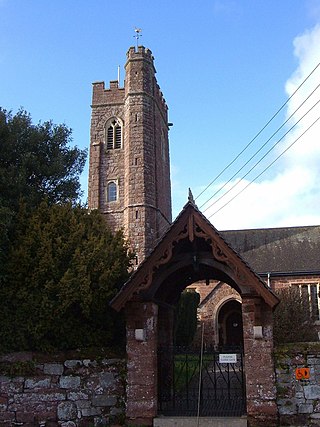
Clyst St George is a village and civil parish in East Devon, England, adjoining the River Clyst some 4 miles (6.4 km) southeast of Exeter and 5 miles (8.0 km) north of Exmouth.

Poltimore is a village, civil parish and former manor in the East Devon district, in the county of Devon, England. It lies approximately 5 miles (8.0 km) northeast of Exeter. The parish consisted of 122 households and a population of 297 people during the 2011 census. The parish also includes the hamlet of Ratsloe.

Payhembury is a village and civil parish in the East Devon district of Devon, England.
References
- 1 2 "THE HUNDREDS OF DEVON: Cliston". GENUKI. Retrieved 30 March 2018.